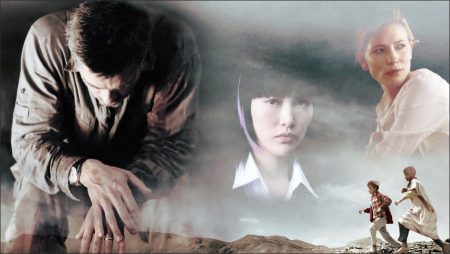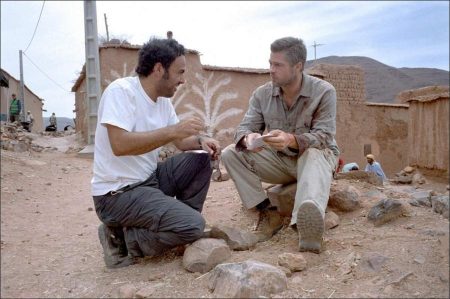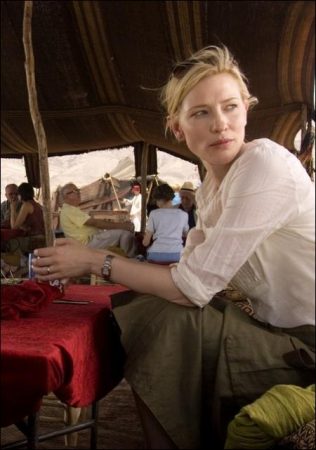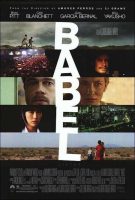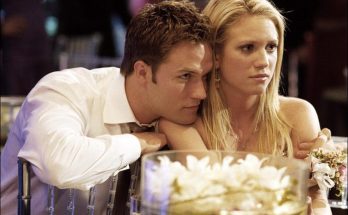The Heart of the Matter
At the center of BABEL is the subject at the core of 21st century life: lack of communication. “On a conventional level (and conventions are sometimes useful to tell stories,) it can be said that BABEL is about miscommunication, but for me, at the bottom line, the film is about how vulnerable and fragile we are as human beings and when a link is broken, it’s not the link that is rotten but the chain itself.”
By this he doesn´t mean the obvious definition of language barriers. “You don’t have to be lost in the Morocco desert or in the middle of the Shibuya district to feel that you are isolated. The most terrifying loneliness and isolation is the one that we experiment with ourselves, our wives and our children,” explains Iñárritu. “For the third time, this is a story about parents and their children.“ With BABEL, he wanted to explore the contradiction between the popular perception that this is such a small world with apparently so many new tools of communication and the equally strong sense that humans still can’t express and communicate with each other at the most fundamental levels.
“I wanted to try to capture the whole idea of human communication – its ambitions, its beauty and its problems –with one word,” he says of choosing BABEL to name his film, even though the title was picked after the screenplay was written. “I considered so many different titles, but when I thought of the story of Genesis, it made so much sense as a metaphor for the film. Each of us has his own different language, but I believe we all share the same spiritual spine.”
Having the idea of making a film with a cacophony of human voices before starting to shoot “21 Grams,” Iñárritu invited, once again, screenplay writer Guillermo Arriaga in order to conclude the trilogy which began with “Amores Perros” in the year 2000. “Arriaga’s talent is extraordinary. His writing is profound and powerful. He has been an amazing collaborator, carving out four narratives that unravel in three disparate parts of the world.” One follows a troubled married American couple who find themselves fighting for their lives in the middle of what may or may not be a terrorist incident while vacationing in the Muslim country of Morocco, where the local language and culture are a constant riddle.
The paradox implied in the relationship between the characters portrayed by Cate Blanchett and Brad Pitt is an example of a more intimate definition of miscommunication: “From the outside, they look like a couple who get lost in the desert, when in reality, they are a lost couple who find one another in their loneliness,” says the director. In a similar case of personal drama, the story of the two children involved in the accident is not so much about its outcome, but about the “moral collapse of a Muslim family strongly guided by spiritual principles,” who watch how these principles crumble to the ground once the events start to unfold.
A second tale revolves around a Mexican nanny working amidst the wealth of California, who makes the fateful decision to bring two American children illegally across the border. Her story is a fable that sums up the situation of thousands of people who try to cross the U.S. border, and face the double standard set by both Mexican and American governments. They become what the director calls “invisible citizens,” left to their destinies by both countries, in any case unprotected by proper immigration laws. “For me, living as an immigrant in the U.S., telling a story about the border wasn’t a choice, it was a moral decision,” says Iñárritu.
A third story focuses on a widowed father, trying to emotionally connect with his deaf daughter in the middle of the intensely urban setting of Tokyo. The tale of a teenager who falls into sexual extremes as a way to make up for affection, ultimately expresses the need to develop a language. “When to touch or to be touched by words is not an option, then the body becomes an instrument, as a weapon or an invitation,” says the director.
Ultimately, Iñárritu contends that the language of film is one way that artists can break through the borders and miscommunication between people around the world: “I believe that languages can be like a mirage that misleads and confuses us. They can make us more suspicious of people we see as others. But I also think there’s no tool more perfect for breaking away from the language barrier than powerful images and music. Images don’t need translation because they trigger universal human emotions. Film is the closest to Esperanto as it gets.,“ says Iñárritu.
A Real Life Casting
To bring to life the array of diverse characters in BABEL, Iñárritu knew he would need to assemble an entirely international cast of actors. He began with the American couple who find themselves the victims of a shooting while on vacation in the mountains of Morocco. For these roles, the director cast two of Hollywood’s most sought-after actors: box-office star Brad Pitt and Academy Award winner Cate Blanchett.
In the role of Richard Jones, Iñárritu had a vision of “an icon of the All-American male,” faced with trouble in a Muslim country in the days we are living in now. He felt Pitt was not an obvious choice for the part, but a very interesting one. “He hasn’t done this type of role before, and I felt it was a challenge and I was excited — and I think he was too – to transform him into a middle-aged man in crisis. He did an amazing job and gave me everything he had.”
For the actress who would portray Richard’s wife, Susan, Iñárritu likewise knew he would need an actress of consummate skill and depth. “I felt that only an actress of Cate’s range and scale could deliver something interesting from what is essentially `lying on the floor’. The director says Blanchett raised the bar in terms of acting on the set. “She’s a princess and she has the power to transform herself into anything she wants. I relied on her to sustain the gravity of the story. As a director, she makes your life so easy,” he says. “She proved that small parts don’t exist. It’s just about what you do with them. “
BABEL marks the first time Iñárritu has directed non-actors, a decision he did not make lightly. “Working with non-actors was a great challenge, but it also made everything more real,” he notes.“When we started casting, I realized that professional actors in Morocco could look like fake desert people. Their skin was too smooth and their look too well-groomed for the part.”
Carpenters, computer programmers, and humble store owners were hand-picked by the casting department, formed by two French and one Mexican collaborators. Arriving at humble villages in the Sahara, casting calls were announced from the speakers of their mosques, and hundreds of people lined up to be taped, in what Iñárritu considers the best decision taken in the film. For the portrait of two young Moroccan brothers, Yussef and Ahmed, whose boyish attempt to test their rifle’s range has startling results for them and their whole village, Iñárritu and his casting team found Boubker Ait El Caid and Said Tarchani. Through extensive local casting calls that drew thousands of young Moroccans, they were chosen because their haunting expressive faces stood out in the crowd.
For the gripping story of a lost nanny that unfolds against the U.S.-Mexico border, Iñárritu began to search for Amelia, the illegal immigrant character who crosses back over the border for her son’s wedding. To cast the role, the director auditioned hundreds of bilingual actresses, looking for that elusive combination of determination and vulnerability that Amelia embodies. It was just alter, that his wife, Maria Eladia, reminded him of the actress that he worked with in “Amores Perros.”
Adriana Barraza sent a tape to the director and immediately proved herself perfect for the part. “Every scene she performed hit me in the heart and the gut.” She has that quality of unconditional maternal love, a loving mother, who is also tough and endures a lot of pain”, he says. Also key to the story that unwinds in Mexico are the children Amelia brings with her over the border: Mike, who is played by newcomer Nathan Gamble, and Debbie, who is portrayed by Elle Fanning, sister of Dakota. It’s through their wide-eyed, unpolished perspective that Iñárritu unveils an unseen side of Mexico. “There are some prejudices that exist in American society about Mexico, so I wanted to show the country through the eyes of children, where there is an air of innocence and sense of discovery,” reveals the director. “What can be judged as dirty, eccentric and poor, in the eyes of kids can be playful, colorful, different and fun.”
To play Santiago, Amelia’s nephew who drunkenly leads her and the children into their own desert odyssey, Iñárritu turned to Gael Garcia Bernal, the actor whom the director first discovered when he cast him as Octavio in “Amores Perros,” and has since become an international star. Gael had been on my mind since the first time I thought about this story. I couldn’t end this triptech without him. He’s one of my favorite actors in the world. He portrayed subtlely the complicated nature of Santiago who represents the double nature of a certain type of Mexican man, who can be lovely, friendly and enthusiastic, but when he drinks, can be very irresponsible, angry and resentful,” he comments. “He also represents how some Mexicans who cross the borders every day, feel about American authority. Santiago’s sudden rage is not because of that night or because he is drunk, but because of the sum of years of humiliation and resentment that he has been holding back for a long time.”
Perhaps the most intimate story in BABEL is the portion that unfolds amidst the crowds, chaos and constant motion of Tokyo. For the role of Yasijuro, the father who cannot emotionally reach his daughter, Iñárritu cast one of Japan’s most prestigious actors, Koji Yashuko. Though the role is small, the director knew he needed an actor who could leave a powerful and memorable mark in a short span of time. “The father appears in just a couple of scenes, but we had to find an actor who had so much presence and gravity that you remember him long after his scenes have passed,” states Iñárritu, who admires the actor’s “economy of movement.”
In December of 2004, Iñárritu also began auditioning for the complex role of Yasijuro’s daughter: the angry, sexually exploring, deaf mute, Chieko. When 24-year-old Rinko Kikuchi came in for a reading, Iñárritu was “blown away by her talent, but reluctant to the fact she wasn’t deaf.” Kikuchi was so determined to get the part, that she began taking lessons in sign language for 9 months, based on her own decision, without the certainty that she would get the part. Though he continued to audition dozens of deaf teenagers for several months, unable to find the spirit that he needed for Chieko, he finally decided upon Rinko. “It was a very brave and wise decision,” comments Iñárritu on her determination to learn sign language. “Sometimes the magic and art of performance is about transformation.”
The challenge of directing foreign non-professional actors meant for the director not only trying to decipher their cultural points of view, but also teaching them to perform some actions or react to certain situations for the very first time. “Directing actors is difficult. Directing actors in another language that you more or less speak is very difficult, as I already knew from 21 Grams but directing non-actors in a language where you don’t have a clue, that’s the most stupid, irresponsible, challenging and satisfying idea that I have ever had,” he says.
To help Iñárritu with this obstacle of communication, he was fortunate to have the assistance of three amazing women, who more than “translators,” enabled the director to transcend the barrier of language and direct as if language was not an issue. “Fortunately in Morocco, I relied on Hiam Abbass, who more than an language coach or translator, was the person who really helped me to build the emotional link with the Arabic non-actors. Without her, I would never have been able to make it,” he says. He continued to say that, “The same is true of Mariko and Rieko in Japan. Mariko, our deaf translator, enabled me to communicate with the deaf cast members and, together, we were able to bridge the gap that could have so easily have misunderstood and thus collapsed. Rieko, who was my Japanese language translator, allowed my voice to be heard and understood, which given the circumstances, was no easy task.” For the director, they were his saving grace.
The Look of Babel
In a departure from his previous films, González Iñárritu sought to combine in Babel the hyper-realism esthetics of certain scenes, with dream-like sequences in the purest cinematic tradición that show the inner lives of the characters.
Key to achieving this was Oscar-nominated cinematographer Rodrigo Prieto’s mastering of visual narratives: “We wanted to visually represent the emotional journeys of the characters through the use of different film stocks and formats. We felt that subtle differences between the image quality of each story, like the texture of the film grain, the color saturation, and the sharpness of the backgrounds could help enhance the experience of being in different places geographically and emotionally,” says Prieto. “We then digitally combined the different lens formats used into one negative, in the same way that all these cultures and languages come together in one film.”
The almost documentary style becomes a challenge in itself when the production requirements happen to be so high as they were in BABEL. While the deserts in South Morocco and Mexico lacked the essential technological support, a hyper-modern city such as Tokyo was for the opposite reasons full of obstacles faced by the production departments. “It was one of the toughest experiences of my life, though one of the most unforgettable and gratifying,” says Academy Award-winning production designer Brigitte Broch. “From working in the most amazing landscapes in Morocco to watching the strangest mixture of society in Tokyo, this film has shaped me in my better understanding of mankind. We decided to paint the film by country in the red tones; the orange earth tones for Morocco, the electric vivid red for Mexico and more toward the subtle red-purple for Japan,” says Broch.
For director González Iñárritu, the true achievement consists of making his and his art and photography departments’ efforts invisible to audiences without showing off. This effort was also implied in the self-imposed task of not succumbing to the esthetical temptations offered by places as visually attractive as the cities portrayed.
Efforts of this kind were also put in the editing room. “I love working with Alejandro because he is relentless,” says editor Stephen Mirrione. Oscar winner. “He’s not satisfied unless every frame in the film makes you feel something. In editing BABEL that meant being focused microscopically on every detail within each scene. Over 2,500 distinct camera setups were shot, giving us an overwhelming palette of images and sounds to choose from. There are roughly 4,000 cuts in the film, so like assembling a massive mosaic from tiny intricately designed tiles, the work we all accomplished only became clear to me after stepping back and watching with a little distance. I am still discovering new details, new connections, and new layers of meaning with every viewing.”
Martin Hernandez, a close friend of Iñarritu’s, began collaborating with him 22 years ago when they were working for a radio station in Mexico City. “When there’s nothing to listen to, there’s nothing to understand; if we stop understanding, then our language has become useless, even worse, in the end it will only divide us. Alejandro Gonzalez Iñarritu´s BABEL is a very detailed description on this subject at the only level that becomes truly universal: the human level. It is filled with some very subtle and some very strident characters, all of them powerfully visual and sonorous. When I was on location for BABEL trying to record the sounds in every space captured for the film, I thought I was there to hear. I was wrong. Now that I’m here, in front of Alejandro’s last cut, I am really listening. I’ve learned to listen to what he hears, and now I’ve been able to understand him. This movie expects the same attention as any human being demands, it is more about them, about the `other’, about the apparent stranger, hence in the end, it’s all about ourselves,” says Hernandez.
Adding the final touches of feeling and depth to the film is another long-time partner of Iñárritu’s – composer Gustavo Santaolalla, who most recently wrote the Oscar-winning score for Brokeback Mountain. “BABEL was the third motion picture I had the chance of working with Alejandro Gonzalez Iñarritu on. Since “Amores Perros” and through “21 Grams” we’ve been developing a particular musical language that helps us to connect with the humanistic, visceral and heartfelt essence of his movies.
The challenge with “Babel” is the four stories that take place in three very different parts of the world was to find a sound, a leading instrument that would connect all the characters and places, keeping an identity but not sounding like the music of a National Geographic documentary. That voice I found in an instrument called the oud, an Arab fretless instrument, ancestor of the Spanish guitar that also echoes the Japanese koto. That sound in combination with other instruments is what created the sonic fabric of Babel,” says Santaolalla.
The crew of top rate collaborators conformed by Prieto, Broch and Santaolalla, along with sound designer Martín Hernández, have been integral members of González Iñárritu team since Amores Perros, his successful debut film. The artistic bond already established between them made the BABEL experience even more intimate and transforming. They comprise what he calls his “creative close family,” essential in the process of translating a vital experience to a language as universal as film.
“Over the course of the year, we lived around the world like a big circus of gypsies. Even when a film can be a close and personal testimony of oneself, making a film is a huge collaborative process. It’s a creative orgy in which everybody gives the best of their talents and I owe to all of my team and collaborators, the best and most satisfying moments, both in the film and out of it. Without them, it would have been impossible to conceive even an inch of film.,” says the director.
For this project, Iñárritu also invited producers Jon Kilik and Steve Golin to complete his “team” of collaborators. “It was great to be able to rely on the family that had been with me during the past two films, but it was also amazing to have worked with new friends and partners, Jon Kilik and Steve Golin. We went through a lot over the course of the film, but their spirit, experience and support was indispensable for this project,” says Iñárritu.
From the point of view of a producer, BABEL posed numerous challenges, but the biggest goal of all was to maintain the creative integrity of the film. “BABEL became the most demanding and the most rewarding producing challenge of my career,” said producer Jon Kilik (Alexander, Malcolm X, Dead Man Walking). “Remote deserts, highly secured international borders, and one of the most densely populated cities on the planet made for enormous production challenges while embracing the lifestyle and work style of Morocco, Mexico and Japan resulted in an honesty on the screen that I am extremely proud of.”
Producer Steve Golin (Eternal Sunshine of a Spotless Mind and Being John Malkovich) shared a similar experience. “This was my first collaboration with Alejandro and the experience of working on BABEL was not only memorable, but unlike any other film I have been a part of. Each day provided me an opportunity to witness people’s methodologies of filmmaking within an international setting and I was continually challenged and inspired as a producer. Having to overcome the obstacles and boundaries of language to find a way of working with one another helped to make this journey truly unique.
Imagining Babel
Each of the locations of BABEL has played a role in Alejandro González Iñárritu¹s life. The director took a life-changing trip to Morocco at age17, and from the minute he was first introduced to that country’s shimmering deserts and soulful mountains, he determined he would one day make a movie there. In this age of terrorism, the setting became even more relevant to Iñárritu’s story of mixed up communication and mistaken motives.
Guillermo brought the argument of the two Moroccan boys to the beginning of the project. It was so powerful, beautiful and simple at the same time that it made it unique. It was first set in Tunisia but I knew I had to make it in this African-Mediterranean corner.”
Similarly, the director’s previous visits to Japan inspired him to commit to returning one day with a movie camera. In 2003, he went to that country to promote 21 Grams, and visited a place called Hakone, a landmark mountain with steaming thermal waters that struck him as magical. The image of an old man taking care with love and dignity, of a mentally-retarded adolescent Japanese girl, while climbing up the Hakone mountain had such a powerful effect on him that it led to the idea of telling the story of a relationship between one isolated person and another. Later on, the strange and constant appearance of deaf people in that same trip, plus an erotic dream that he had of a deaf teenager in the dentist’s office was the seed of the Japanese story.
Another weighty influence on Iñárritu as he forged BABEL was his own recent move from his former home in Mexico City to the United States. Iñárritu knew he wanted to set one of his stories against the deadly and highly contentious border between the U.S. and Mexico. “Being an immigrant myself, I gained a clearer perspective of myself, my country and my own work. I also now understand what it feels like being a Third World citizen living in the First World country, and the complexity of its significance.”
Babel as a First Hand Experience
Production on BABEL began in Morocco in May of 2005, then moved on to Mexico and Tokyo. In Morocco, the key was finding a location to stand in for a small, tight-knit enclave in the southern desert. Iñárritu found the remote Berber village of Taguenzalt. Located in the foothills of the Atlas Mountains, the village, built into the rocky gorges of the Draa Valley, boasts ancient, adobe-style houses with rooms facing around an inner courtyard. “I liked that this village was very humble and very real,” comments Iñárritu. “The people in Taguenzalt were extremely nice and spiritual. And I mean really spiritual. I felt safe there.”
Despite the warm hospitality of the people, the conditions in Morocco could be daunting. Temperatures often soared to 98 degrees, with afternoon windstorms whipping up sands from the southern Sahara. Yet the discomfort only added to the gritty realism of BABEL. “The heat was brutal and uncomfortable, but it’s precisely what this story is about. This was not only method acting but method execution, says Iñárritu.
After Morocco, production hopped back to Tijuana, Mexico, where once again, in parallel with the fiction, the production found themselves in a dusty, sweltering desert and a tiny, secluded village. Here the rural, Norteno town of El Carrizo stood in for Amelia’s ramshackle home in the “Los Lobos” hamlet. Key sequences were also shot along the border between Mexico and California, where Iñárritu captures the view from the Mexican side – with its extensive fencing, surveillance cameras, mega-watt stadium lighting and armed guards creating a fortress-like atmosphere. “Five people were in the hospital in the Sonoran desert. Adriana Barraza almost suffered from heat stroke on set. It wasn’t easy,” says the director.
Finally, Iñárritu and his crew arrived in Tokyo, which despite being the only urban setting in the film was rife with its own challenges. “Tokyo was both a wonderful experience and a difficult one,” states Iñárritu. “Things work slowly there and there’s no film commission to help you through. There’s no permission to shoot anything, so you are always escaping from the police at every corner. We had to be brave and work like a guerilla-style crew, ready to improvise, moving fast.
Every phase in the making of BABEL, both mirrored the situations endured by the characters, and transformed the fictional story by effect of new learnings on cultural clashes. Everyday, I was adjusting and adapting the script, depending on how the culture struck me, he says. If the film molded reality or the other way around, it’s better left there for the audiences to guess.
Babel (2006)
Directed by: Alejandro González Iñárritu
Starring: Brad Pitt, Cate Blanchett, Gael Garcia Bernal, Koji Yakusho, Elle Fanning, Rinko Kikuchi, Adriana Barraza, Harriet Walter, Mohamed Akhzam, Wendy Nottingham
Screenplay by: Guillermo Arriaga
Production Design by: Brigitte Broch
Cinematography by: Rodrigo Prieto
Film Editing by: Douglas Crise, Stephen Mirrione
Costume Design by: Gabriela Diaque, Miwako Kobayashi, Michael Wilkinson
Music by: Gustavo Santaolalla
MPAA Rating: R for violence, some graphic nudity, sexual content, language.
Distributed by: Paramount Vantage
Release Date: November 10, 2006
Visits: 220
